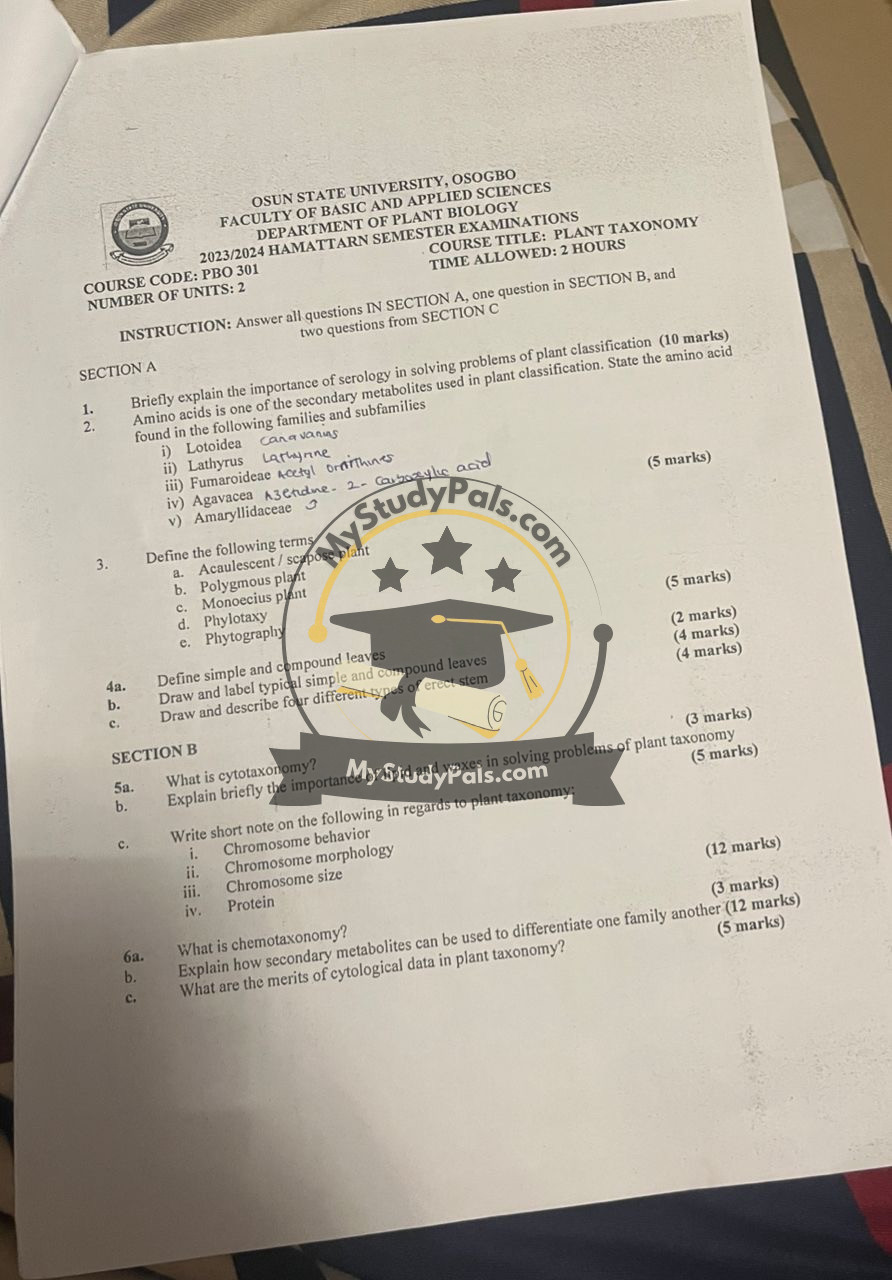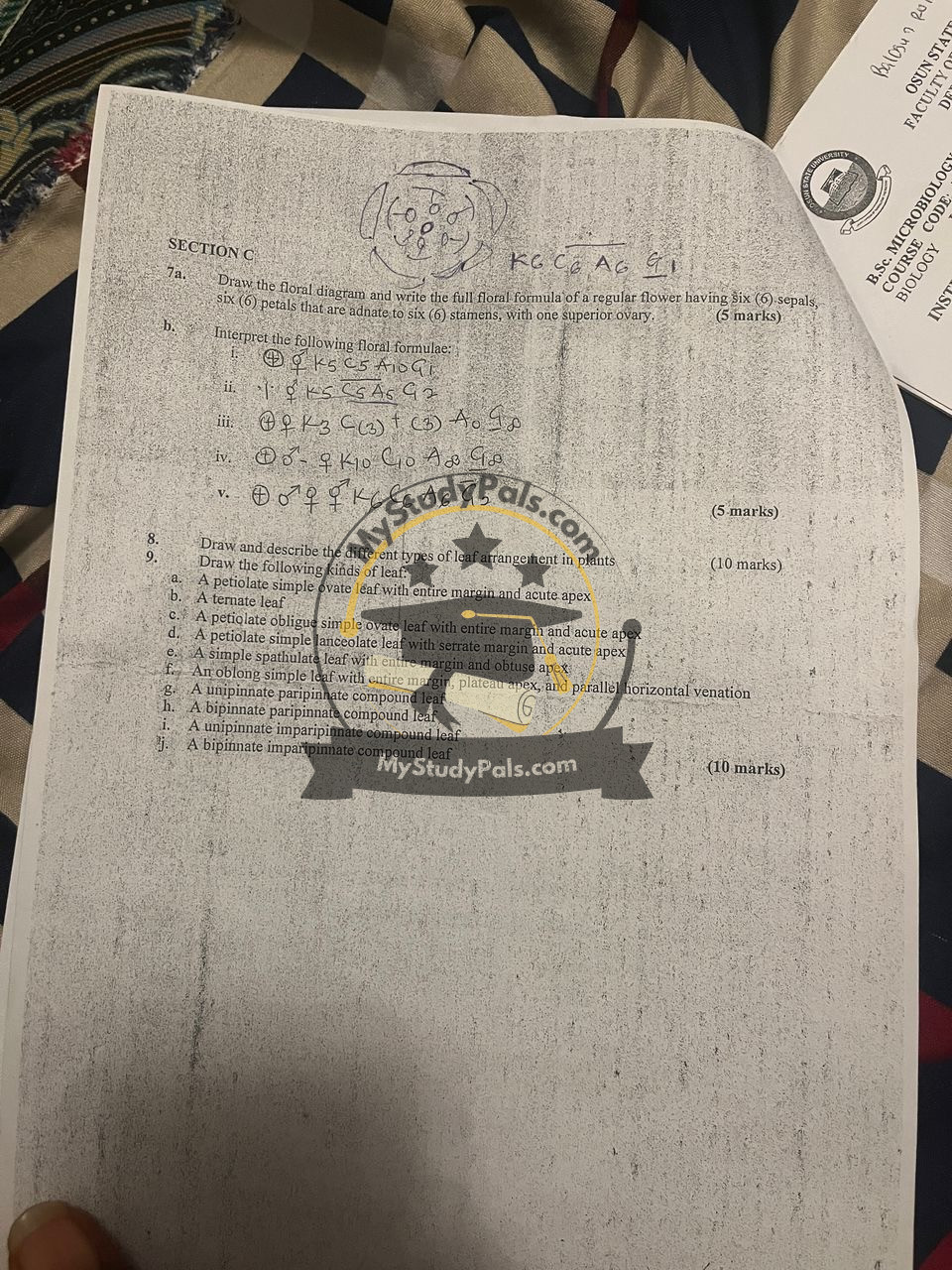ANWSER
—
### SECTION A
Question 1:
Answer:
Serology is important in plant classification because it uses antigen-antibody reactions to compare proteins in different plant species. This helps identify similarities and differences, resolve taxonomic ambiguities, and establish evolutionary relationships.
—
Question 2:
Answer:
The amino acids found in the following families/subfamilies are:
i) Loididea: Not specified (may require reference to specific literature)
ii) Lathyrus: Lathyrosine
iii) Fumaroideae: Fumaric acid derivatives
iv) Agavaceae: Tyramine
v) Amaryllidaceae: Lycorine (alkaloid-derived amino acids)
—
Question 3:
Answer:
a. Acaulescent/scapose plant: A plant with no visible stem, leaves arising from ground level (e.g., dandelion).
b. Polygamous plant: A plant bearing both bisexual and unisexual flowers (e.g., mango).
c. Monoecious plant: A plant with separate male and female flowers on the same individual (e.g., maize).
d. Phylotaxy: The arrangement of leaves on a stem (e.g., alternate, opposite, whorled).
e. Phytography: The descriptive study of plant morphology for taxonomic purposes.
—
Question 4:
Answer:
– Simple leaf: A single undivided blade (e.g., mango leaf).
– Compound leaf: A leaf divided into multiple leaflets (e.g., neem leaf).
*(Drawing not provided here, but labels should include petiole, blade, midrib, and leaflets for compound leaves.)*
—
Question 5:
Answer:
Four types of erect stems:
1. Herbaceous stem: Soft, green (e.g., sunflower).
2. Woody stem: Hard, lignified (e.g., oak tree).
3. Succulent stem: Fleshy, water-storing (e.g., cactus).
4. Climbing stem: Twines or uses tendrils (e.g., pea plant).
*(Drawings should show cross-sections or growth habits.)*
—
### SECTION B
Question 6:
Answer:
Cytotaxonomy is the use of chromosome data (number, structure, behavior) in plant classification.
Lipids and waxes help differentiate species based on cuticular wax patterns or seed oil composition, providing chemotaxonomic markers.
—
Question 7:
Answer:
Short notes:
i. Chromosome behavior: Meiotic pairing reveals genetic relationships.
ii. Chromosome morphology: Size, shape, and banding patterns aid identification.
iii. Chromosome size: Genome size variation can indicate speciation.
iv. Protein: Electrophoresis of proteins (e.g., enzymes) compares genetic similarity.
—
Question 8:
Answer:
Chemotaxonomy classifies plants based on chemical constituents (e.g., alkaloids, flavonoids).
Secondary metabolites differentiate families; e.g., betalains in Caryophyllales vs. anthocyanins in others.
Merits of cytological data: Provides objective evidence for relationships, resolves hybridization events, and supports molecular data.
—
### SECTION C
Question 7a:
Answer:
– Floral formula: \(\bigoplus \phi K_6 C_6 A_6 G_{(1)}\)
– \(\bigoplus\): Radial symmetry
– \(\phi\): Bisexual
– \(K_6\): 6 sepals
– \(C_6\): 6 petals
– \(A_6\): 6 stamens
– \(G_{(1)}\): Superior ovary, 1 carpel
*(Drawing: Circular diagram with labeled whorls.)*
—
Question 7b:
Answer:
Interpretations:
i. Radial, bisexual, 5 fused sepals, no corolla, 1 superior ovary.
ii. Zygomorphic, bisexual, 5 fused sepals, no corolla, 2 superior ovaries.
iii. Radial, bisexual, 3 sepals, 3+5 stamens, no ovary.
iv. Radial, unisexual, 10 fused sepals, no stamens, no ovary.
v. Radial, male, 6 sepals, 6 stamens, no ovary.
—
Question 8:
Answer:
Leaf arrangements: Alternate, opposite, whorled, rosette.
*(Drawings should include:)*
a. Petiolate ovate leaf (e.g., hibiscus).
b. Ternate (3 leaflets; e.g., clover).
c. Oblique ovate leaf (e.g., begonia).
d. Lanceolate serrate leaf (e.g., willow).
e. Spatulate leaf (e.g., purslane).
f. Oblong leaf (e.g., banana).
g-j. Pinnate compound leaves (even/odd leaflets; e.g., rose, acacia).
—



